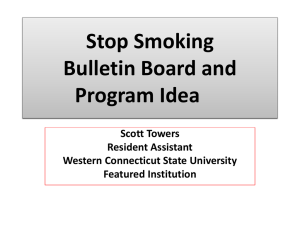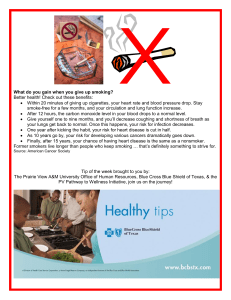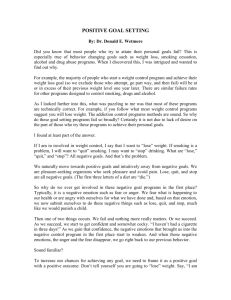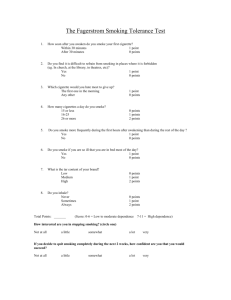How Can I Quit Smoking? Why should I quit smoking?
advertisement
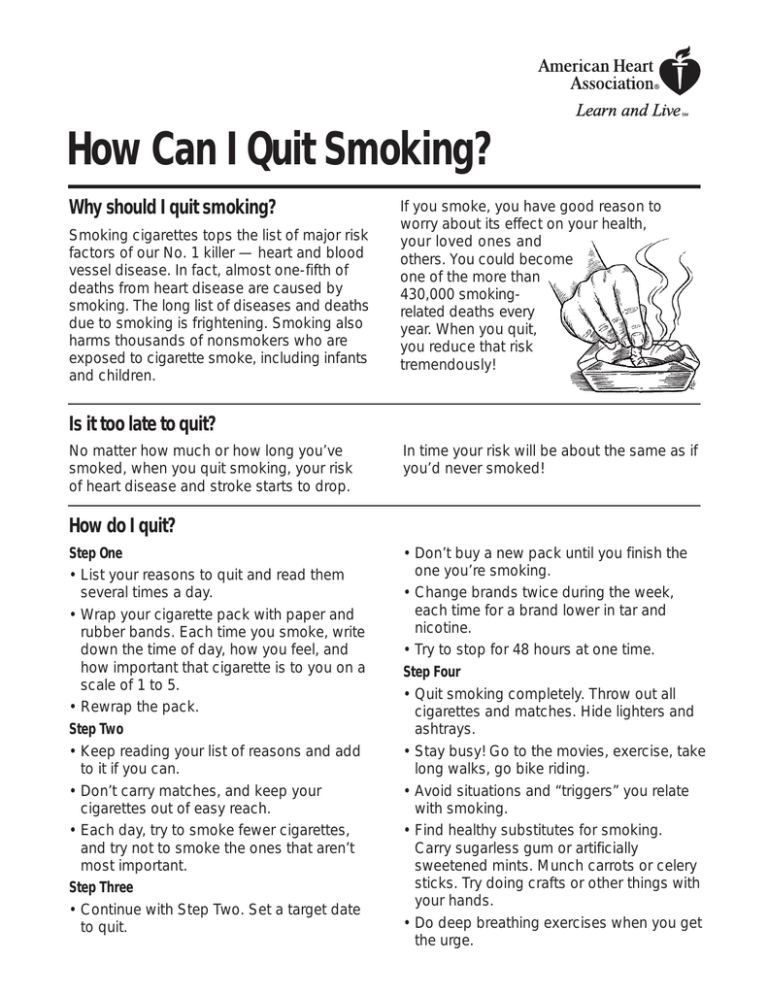
How Can I Quit Smoking? Why should I quit smoking? Smoking cigarettes tops the list of major risk factors of our No. 1 killer — heart and blood vessel disease. In fact, almost one-fifth of deaths from heart disease are caused by smoking. The long list of diseases and deaths due to smoking is frightening. Smoking also harms thousands of nonsmokers who are exposed to cigarette smoke, including infants and children. If you smoke, you have good reason to worry about its effect on your health, your loved ones and others. You could become one of the more than 430,000 smokingrelated deaths every year. When you quit, you reduce that risk tremendously! Is it too late to quit? No matter how much or how long you’ve smoked, when you quit smoking, your risk of heart disease and stroke starts to drop. In time your risk will be about the same as if you’d never smoked! How do I quit? Step One • List your reasons to quit and read them several times a day. • Wrap your cigarette pack with paper and rubber bands. Each time you smoke, write down the time of day, how you feel, and how important that cigarette is to you on a scale of 1 to 5. • Rewrap the pack. Step Two • Keep reading your list of reasons and add to it if you can. • Don’t carry matches, and keep your cigarettes out of easy reach. • Each day, try to smoke fewer cigarettes, and try not to smoke the ones that aren’t most important. Step Three • Continue with Step Two. Set a target date to quit. • Don’t buy a new pack until you finish the one you’re smoking. • Change brands twice during the week, each time for a brand lower in tar and nicotine. • Try to stop for 48 hours at one time. Step Four • Quit smoking completely. Throw out all cigarettes and matches. Hide lighters and ashtrays. • Stay busy! Go to the movies, exercise, take long walks, go bike riding. • Avoid situations and “triggers” you relate with smoking. • Find healthy substitutes for smoking. Carry sugarless gum or artificially sweetened mints. Munch carrots or celery sticks. Try doing crafts or other things with your hands. • Do deep breathing exercises when you get the urge. How Can I Quit Smoking? (continued) What if I smoke after quitting? It’s hard to stay a nonsmoker once you’ve had a cigarette, so do everything you can to avoid that “one.” The urge to smoke will pass. The first 2 to 5 minutes will be the toughest. If you do smoke after quitting: • This doesn’t mean you’re a smoker again — do something now to get back on track. • Don’t punish or blame yourself — tell yourself you’re still a nonsmoker. • Think about why you smoked and decide what to do the next time it comes up. • Sign a contract to stay a nonsmoker. What happens after I quit? • Your senses of smell and taste come back. • Smoker’s cough goes away. • You will digest normally. • You feel alive and full of energy. • You breathe much easier. • It’s easier to climb stairs. • You’re free from the mess, smell and burns in clothing. • You feel free of “needing” cigarettes. • You’ll live longer and have less chance of heart disease, stroke, lung disease and cancer. How can I learn more? 1. Talk to your doctor, nurse or other healthcare professionals. If you have heart disease or have had a stroke, members of your family also may be at higher risk. It’s very important for them to make changes now to lower their risk. 2. Call 1-800-AHA-USA1 (1-800-242-8721), or visit americanheart.org to learn more about heart disease. 3. For more information on stroke, call 1-8884-STROKE (1-888-478-7653) or visit us online at StrokeAssociation.org. We have many other fact sheets and educational booklets to help you make healthier choices to reduce your risk, manage disease or care for a loved one. Knowledge is power, so Learn and Live! Do you have questions or comments for your doctor or nurse? • Take a few minutes to write your own questions for the next time you see your healthcare provider. For example: When will the urges stop? How can I keep from gaining weight? The statistics in this sheet were up to date at publication. For the latest statistics, see the Heart Disease and Stroke Statistics Update at americanheart.org/statistics. ©1994, 2002, 2004, American Heart Association.
